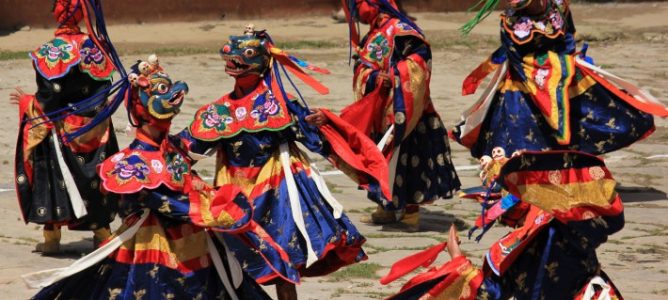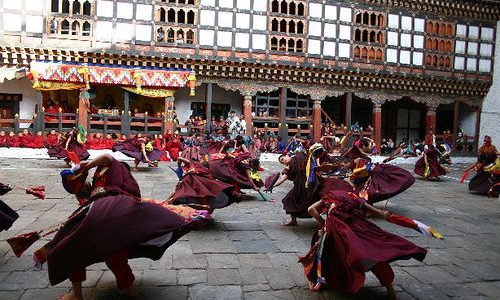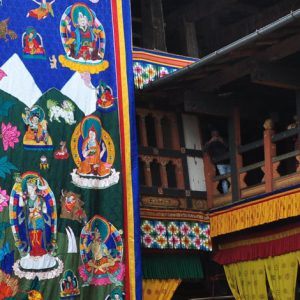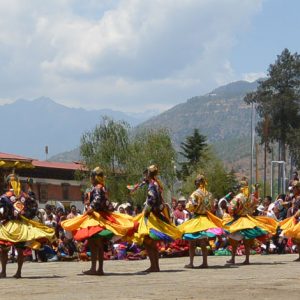Day 1: PARO INTERNATIONAL AIRPORT – PARO (L/D)
Upon arrival at Paro International airport, you will be met by your guide..
After lunch visit Ta Dzong (built in1656 and renovated in 1968), an ancient watchtower, which now houses the National Museum. Below the museum is the Rinpung Dzong (literally meaning “Heap of Jewels”), the centre of civil and religious authority in this valley, built in 1646 by Zhabdrung Ngawang Namgyal.
Later in the afternoon, you will have an opportunity to visit the 7th century old Kyichu lhakhang. This temple is one of the oldest lhakhangs to have been built in Bhutan. It is one of the 108 lhakhangs built by the Tibetan king Songtsen Gampo in the 7th century AD. The king is said to have built 108 lhakhangs in a day throughout the Himalayan regions, of which Kyichu lhakhang in Paro and Jampa lhakhang in Bumthang are two. Most of the remaining lhakhangs can be seen in Tibet. Kyichu lhakhang was originally a small structure at the time of its establishment. Owing to Jowo (Buddha) as its main statue, the lhakhang was also known as Jowo lhakhang
In the evening, explore the beautiful town of Paro.
Dinner and overnight at your hotel in Paro.
Day 2: TAKTSANG MONASTERY OR TIGER’S NEST (B/L/D)
After an early breakfast, drive about 16 km from Paro to visit Drugyal Dzong (a ruined fortress). Although it is now in ruins, this dzong has great historical importance for the people of Bhutan. It was a place where the Bhutanese finally defeated the Tibetan invasion. On a clear day one can view sacred Mt. Jomolhari (Mountain of Goddess).
We will then drive to the trail head to take a breathtaking and memorable hike through beautiful pine forest. You will stop for light refreshments at the Taktsang cafeteria before walking on to the Taktsang monastery or Tiger’s Nest. The primary Lhakhang or main temple was built around Guru Rimpoche’s meditation cave in 1684 by the Penlop of Paro, Gyalse Tenzin Rabgay. This incredible monastery clings to the edge of a sheer rock cliff that plunges 900 m into the valley below. Legend has it that Guru Padmasambhava, the tantric mystic who brought Buddhism to Bhutan in 747 AD, flew here on the back of a flying tiger, Dorji Drolo from Kurtoe Singye Dzong in the east. Hiking to this sacred monastery will not only reward you with blessings but also be able to get acclimatized before you embark on the 6-day Druk Path Trek.
In the evening drive through to Thimphu. The drive is along a winding road by the Paro Chu (Chu means water or river) downstream to the confluence with the Wang Chu, then it turns upstream along the Wang Chu to Thimphu, Bhutan’s scenically located capital city.
In the evening visit the Tashichho Dzong, the seat of the national government and the Central Monastic Body which includes the summer residence of the Je Khenpo (Chief Abbot of Bhutan).
Dinner and overnight at your hotel in Thimphu.
Day 3: THIMPHU (B/L/D)
After breakfast drive to Dodeyna to climb through a beautiful forest track to the Tango Monastery which overlooks a forested valley and other Buddhist retreats high in the mountains.
After lunch, visit the National Memorial Chorten built in honour of Bhutan’s late King Jigme Dorji Wangchuck and drive uphill to the Kuensel Phodrang to see a large statue of Buddha Shakya Muni being built.
In the afternoon, you will also get an opportunity to visit National Institute of Traditional Medicines, National Insitute of Zorig Chusum (School of 13 arts & crafts), Royal Textiles Academy and local handmade paper house.
In the evening explore Thimphu town.
Dinner and overnight at your hotel in Thimphu.
Day 4: THIMPHU – PUNAKHA (B/L/D)
Drive to Punakha via the Dochula Pass (3,140 m). On the way stop to see the spectacular array of chortens, to enjoy the superb view over the snow capped Himalayan Mountains and also to the Gasa Dzong at a distance if the weather is clear.
After lunch walk for about 25 minutes along beautiful terraced farmlands and farm houses to visit Chimi Lhakhang, which was built by Lama Drukpa Kuenley (the Devine Madman) in the 15th century. He subdued the demoness with his “Magical Thunder bolt”. The Temple is also known as “the Temple of Fertility”.
Then visit Punakha Dzong. The impressive Punakha Dzong lies between two great rivers. The names of the rivers are Pho Chu (Male River) and Mo Chu (Female River). This Dzong serves as the winter residence for the Je Khenpo, Chief Abbot of the Central Monastic Body and also the office of the district administration.
Dinner and overnight at your hotel in Punakha.
Day 5: PUNAKHA – TRONGSA – BUMTHANG (B/L/D)
After breakfast, drive to Trongsa via the Pelela pass (3300m), the traditional boundary between east and west.
After lunch visit Trongsa Dzong, built in 1644, an ancestral residence of Bhutan’s royal family. Then visit the Ta Dzong, an ancient watch tower built to guard the Trongsa.
Continue driving to Bumthang. Bumthang is one of the most historic districts and has a large number of ancient temples and sacred sites.
Dinner and overnight at your hotel in Bumthang.
Day 6: BUMTHANG (B/L/D)
Bumthangconsists of four mountain valleys of the Ura, Chumey, Tang and Chhoekhor. This spectacular area is the spiritual heartland of Bhutan and home to its most ancient and precious Buddhist place. The tales of Guru Rinpoche (Padmasambhava) and his re-incarnates, known as Lingpas, are still evident and linger in every nook and corner of Bumthang.
Here you will visit some of the most significant and holiest places including Mebar Tsho and Tamzhing Lhakhang.
Mebar Tsho is considered one of the most sacred sites in the region as it relates to the renowned treasure reveler, Terton Pema Lingpa-incarnated disciple of Guru Padmasambhava popularly known as Guru Rinpoche who discovered treasure from the lake in the late 15th century.
Tamshing Lhakhang is located across the river from Kurje Lhakhang. This temple was founded in 1501 by Terton Pema Lingpa, the re-incarnation of Guru Padmashambhava. The monastery has very ancient religious paintings like 1,000 Buddhas and 21 Taras (female form of Buddhisatava). The temple was restored at the end of the 19th century.
The Jambay Lhakhang was built in the 7th century by King Songtsen Gampo of Tibet. It is one of the 108 monasteries built by him to subdue evil spirits in the Himalayan region. Its present architectural appearance dates from the early 20th century.
Explore Chamkhar town in the evening.
Dinner and overnight at your hotel in Bumthang.
Day 7: BUMTHANG – MONGAR (B/L/D)
After an early breakfast, drive to Mongar. Lunch will be served at a farmhouse on the way. If the weather permits, we will stop for a while in Lingmethang and visit Zhongar Dzong.
Dinner and overnight at your hotel in Mongar.
Day 8: MONGAR – TRASHIGANG (B/L/D)
After breakfast, visit Mongar Dzong, which was rebuilt in 1953. This dzong houses the district administration and the central monastic body. Proceed to Trashigang through Korila Pass.
Overnight at your hotel in Trashigang.
Day 9 – 11: TRASHIGANG TSHECHU (B/L/D)
Attend the 3-day colourful Trashigang Tshechu festival. We will also arrange short walking tours among farmhouses in the neighbouring villages of Radhi, Phongmey and Bartsham to experience lifestyles of local people.
Dinner and overnight at your hotel in Trashigang.
Day 12: TRASHIGANG – SAMDRUP JONGKHAR (B/L/D)
After an early breakfast drive through to Samdrup Jongkhar. Stop a while to take photographs at Tshelingkhor which overlooks the valleys of Bhutan’s southern foothills if the weather is clear.
In the evening explore the border town of Samdrup Jongkhar which is the main trading hub for six eastern districts of Bhutan.
Overnight at your hotel in Samdrup Jongkhar.
Day 13: SAMDRUP JONGKHAR – GUWAHITI, INDIA (B)









Reviews
There are no reviews yet.